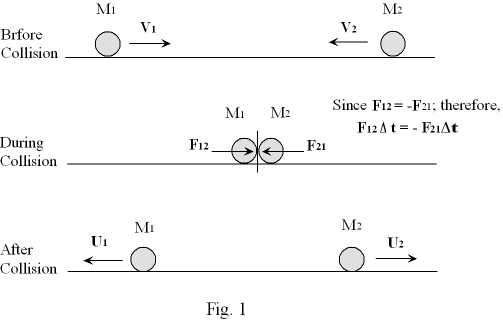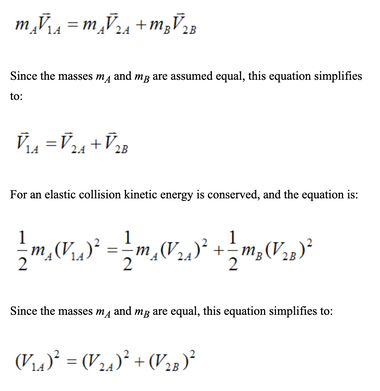Collision
Photo Credit: Real World Physics Problems
There are two types of collisions that could occur while playing pool; elastic or inelastic. An elastic collision is when the kinetic energy from the system is conserved before and after the impact, and an inelastic collision is when kinetic energy is list. Pool balls hitting each other are considered elastic collision because of the conservation of kinetic energy and momentum.
Conservation of Linear Momentum
Photo Credit: Pellissippi State
Conservation of momentum is the total momentum after collision set equal to the total momentum before collision: m1u1 + m2u2 = m1v1 + m2v2
Photo Credit: Real World Physics Problems Photo Credit: Real World Physics Problems
The photo on the left proves that the direction of the ball can be analyzed before even shooting the ball. All of the balls on the table weigh the exact same, therefore the mass can be excluded from our equation. Further simplifying would leave us with a pythagorean theorem equation. This equation tells us that our vectors form a right angle and can be drawn as the photo on the right; ball A moves in a perpendicular direction from ball B post impact.
Photo Credit: Real World Physics Problems Photo Credit: Real World Physics Problems
The overall direction and speed rely on where the pool stick is hitting the cue ball. You will not get the same results if you hit the ball more on top than you would more in the same. Just like you wouldn't be able to hit straight ahead if you shot more left or right than you did straight.
Knowing where to hit the sweet spot ensures the direction of the force is accurate, the ball is forward or backward spinning, and can also determine where the cue ball goes after collision.
Knowing where to hit the sweet spot ensures the direction of the force is accurate, the ball is forward or backward spinning, and can also determine where the cue ball goes after collision.





